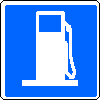 To
Next Fuel (CNG)
To
Next Fuel (CNG)Home - Background: Fuel Types - LPG
Liquefied petroleum gas, as the name suggests, is partly a byproduct of petroleum refining; in California the state's oil refineries are the main source, but nationwide well under half of LPG comes from petroleum refining, and the rest from natural gas processing. It consists of hydrocarbons that are vapors, rather than liquids, at normal temperatures and pressures, but which turn liquid at moderate pressures; its main constituent is propane, and it is sometimes referred to by that name.
Since everything from barbecue grills to portable heaters runs on LPG, and since it is used for home heating in rural areas where natural gas pipelines don't run, there is an extensive distribution network nationwide, and has been for many years.
See above; LPG is easy to find. It may be expensive if you buy it from a retailer who's used to filling five-gallon barbecue-grill bottles, but there are lots of places that will sell you automobile-sized fill-ups at a lower price per gallon.
Because it's so widely available, LPG is the least "alternative" of alternative fuels if "alternative" equates to inconvenience, and most of the alternative fuel used in the United States is LPG. (One might also say, given LPG's dominance of the alternative-fuel market, that it's the most alternative fuel...) In order to liquefy the fuel, it is stored in sturdy tanks at about 20 times atmospheric pressure; since these are much tougher than typical sheet-metal or plastic gasoline tanks, and since they have a built-in shutoff valve to seal the tank if the fuel lines start leaking, LPG is safer than gasoline. (The tanks are a permanent part of the vehicle, unlike barbecue-grill tanks, so they are immune to the usual cause of LPG fires, which is leakage due to the operator's failure to hook the tank up properly.) It is also somewhat cheaper than gasoline in most places at most times, when you compare the price of a gallon of gasoline with the price of the somewhat larger volume of LPG needed to drive the same distance.
Because LPG enters the engine as a vapor, it doesn't wash oil off cylinder walls or dilute the oil when the engine is cold, and it also doesn't put carbon particles and sulfuric acid into the oil. Thus an engine that runs on propane can expect a longer service life and reduced maintenance costs. (Incoming liquid gasoline cools the combustion chamber and valves as it vaporizes, so you might expect, for example, that you'd need a valve job more often on an LPG-burning engine because the gaseous fuel doesn't give this cooling effect. However, modern valve and valve-seat materials, designed for unleaded gasoline, don't have problems with the "dry" fuel. More recently, direct injection of LPG in the liquid state, with attendant cooling effect as well as improved emissions control, is being tested.) Its high octane rating (around 105) means that power output and/or fuel efficiency can be increased, without causing detonation ("knocking"), in a vehicle that isn't required to run on gasoline as well.
LPG is, again, in some ways the least "alternative" of alternative fuels; because its source is partly petroleum, it does less to help relieve the petroleum dependency problem than some other alternative fuels, and given the dominance of the petroleum source in California it is not even considered an alternative fuel for some state incentive programs. On the other hand, nationwide about 90% of LPG is domestically produced (even if a fraction comes from an imported petroleum feedstock), and most of the remainder comes from Canada (which is a heck of a lot more stable than the Mideast!), so LPG does help to remedy the national security component of the overall petroleum dependency problem.
Its somewhat lower energy content compared to gasoline means you need a slightly bigger tank to get the same driving range; the tank will also be heavier because it has to be strong enough to withstand the LPG storage pressure. Mostly because of the special fuel tank, a vehicle that runs on LPG will typically be somewhat more expensive (around $1000-2000) than an equivalent gasoline-powered vehicle. Finally, the refueling procedure on an older-style tank (evolved from that for filling grill bottles) involves the release of some raw fuel vapors (unburned hydrocarbons) into the air, though these are much less reactive (have less "ozone-forming potential") than gasoline vapors; however, I understand that modern propane tanks, and the dispensers that fill them, are designed to eliminate most of this spillage.
...to Roy Willis, president of the Propane Education and Research Council, who reviewed this page and sent me some corrections! In particular, I thought that petroleum refining was the dominant source for LPG nationwide, not just in California, and wasn't aware that advanced refueling connectors are starting to appear outside the lab.
 To
Next Fuel (CNG)
To
Next Fuel (CNG) Back
to Fuel Types
Back
to Fuel Types Back
to Fueling Station
Back
to Fueling Station Site
Map
Site
Map Contact
Me
Contact
Me All content copyright 1998-2024 by Mark Looper, except as noted. Reuse of my copyrighted material is authorized under Creative Commons Attribution 4.0 International license (CC BY 4.0).
![]()
![]()
new 11 July 1998, revised 12 January 2002